Top Supplier Discovery Software Solutions


As procurement professionals, we all know the importance of finding reliable, quality suppliers, especially in an increasingly unpredictable and dynamic market.
However, the process of identifying and vetting potential vendors can be incredibly time-consuming and complex, especially when done manually.
Luckily, there are a lot of supplier discovery software solutions that can streamline this process.
In this article, we’ll examine eight leading systems that are transforming the way businesses approach supplier discovery.
We have a diverse selection, including tools with advanced AI features, those boasting extensive supplier databases, and some platforms that offer a bit of everything.
Let’s begin.
First, we have our AI-powered supplier sourcing platform, Veridion.
Finding the best match requires having a lot of data to sift through.
Veridion has a database of over 79 million companies, at 203 million locations, with company info ranging from basic contact details and size to sustainability insights, industry classification data, and more.
This data is updated regularly, ensuring you get fresh and accurate information about any supplier, regardless of where they are from.
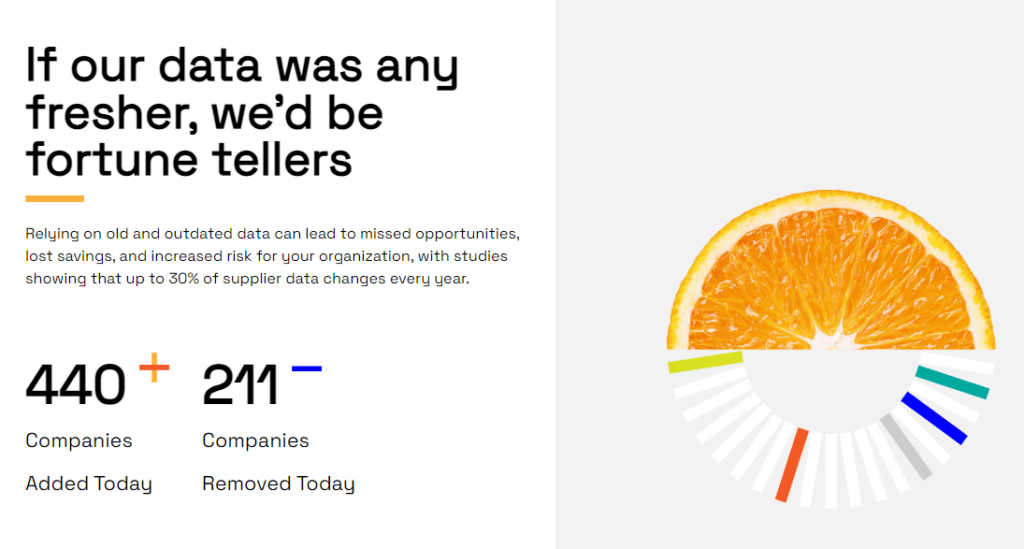
Source: Veridion
Searching through this vast amount of data isn’t done by hand. Our program does that for you, based on the parameters you provide.
You can either look them up using everyday language thanks to our natural language search feature, or use two different APIs.
Our Search API and Match & Enrich API allow you to both find suppliers based on various criteria and enrich your limited supplier data in mere seconds.
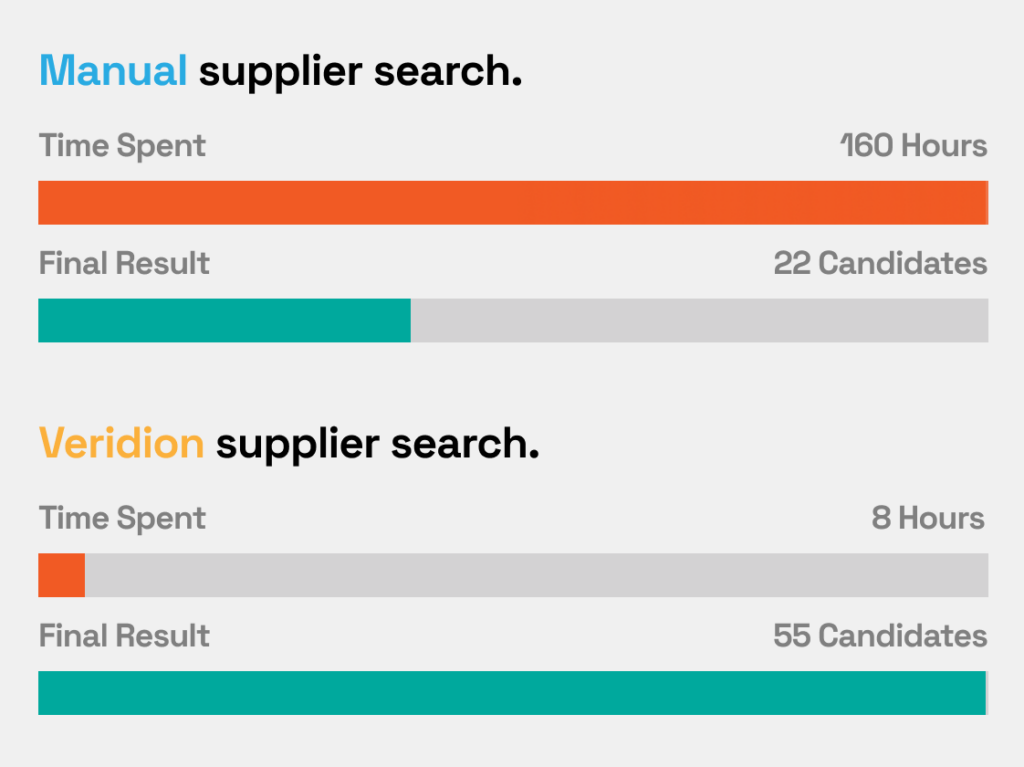
Source: Veridion
Veridion is mostly used by large enterprises that require business data to operate, whether it’s for their procurement, insurance, or market intelligence needs.
Take a look at this brief demo of supplier discovery with Veridion to get a sense of how it works.
Overall, our system provides a large and accurate supplier database that is easily searchable, allowing you to quickly find and evaluate potential suppliers based on your specific needs.
If this sounds like a solution that could benefit your procurement processes, contact us for more information.
Next up, we have apexanalytix, an entire supplier management ecosystem, with a dedicated supplier discovery solution.
This tool allows you to search and engage prequalified suppliers, current suppliers, and apex’s smartvm® database of over 100 million supplier records.
So, it’s designed to streamline your supplier discovery and management all in one place.
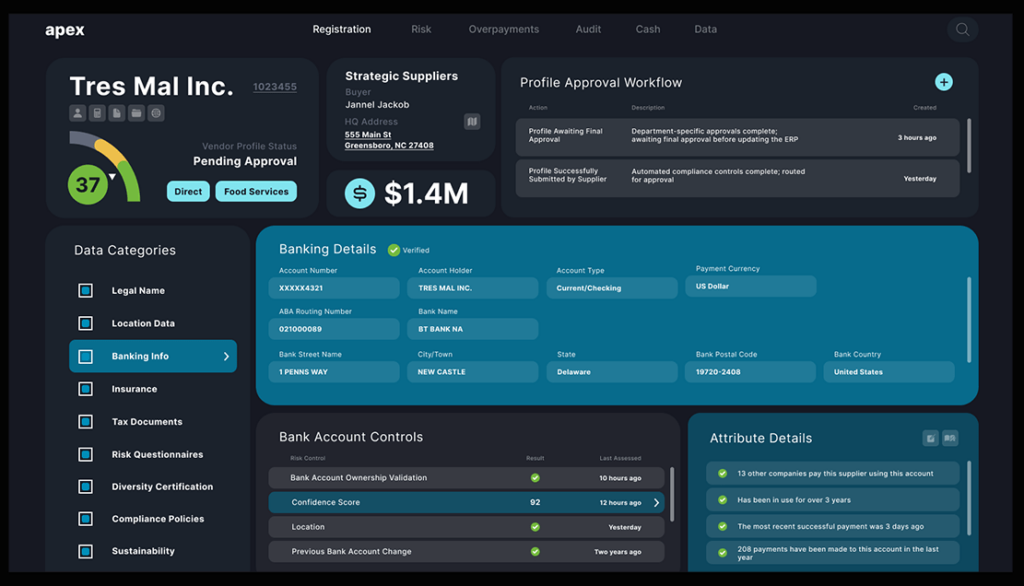
Source: apexanalytix
One of the standout features of this module is the self-registration option for suppliers.
This allows suppliers who are interested in working with your company to “raise their hands,” or proactively reach out and provide their information upfront.
The information can then be automatically prevalidated, stored, and, optionally, routed for internal review.
Apexanalytix offers additional features related to its supplier discovery module, mainly oriented toward finances and fraud prevention. You can see them below.
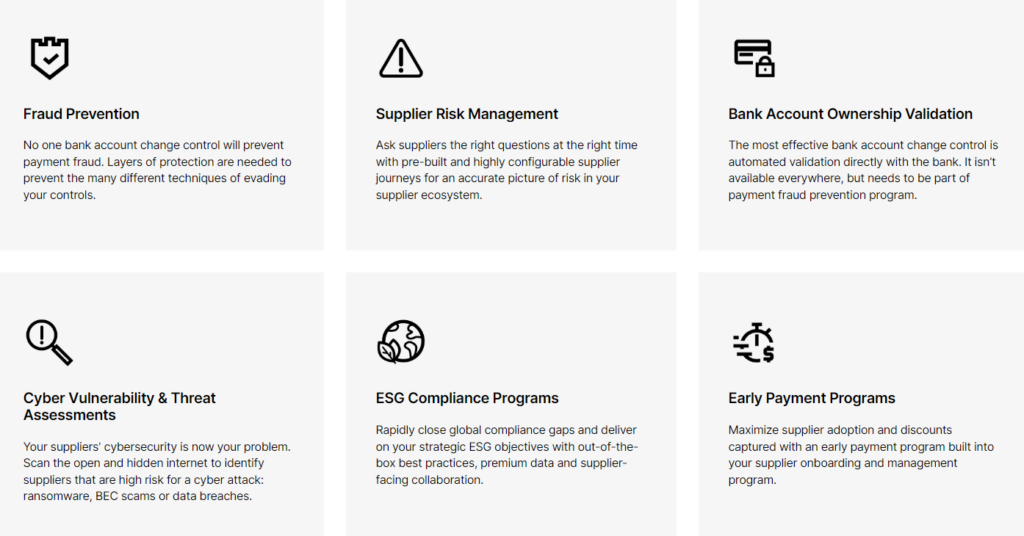
Source: apexanalytix
In essence, this is a great supplier onboarding tool, especially useful if you need to frequently add new suppliers to your network or if you want to create a standardized process for supplier registration.
Take into account that this is a complicated platform, however.
One G2 reviewer stated that while the system is great for supplier management and onboarding, it needs “highly skilled people to use this software and cannot be used by everyone”.
But, if you need to connect your supplier discovery process to a broader management platform, apexanalytix is a great choice.
Find My Factory is an AI-driven platform designed for fast and straightforward supplier discovery in retail, components, or food industries.
What sets this tool apart is its unique way of finding suppliers for specific products through various search options, potentially making the discovery process much smoother.
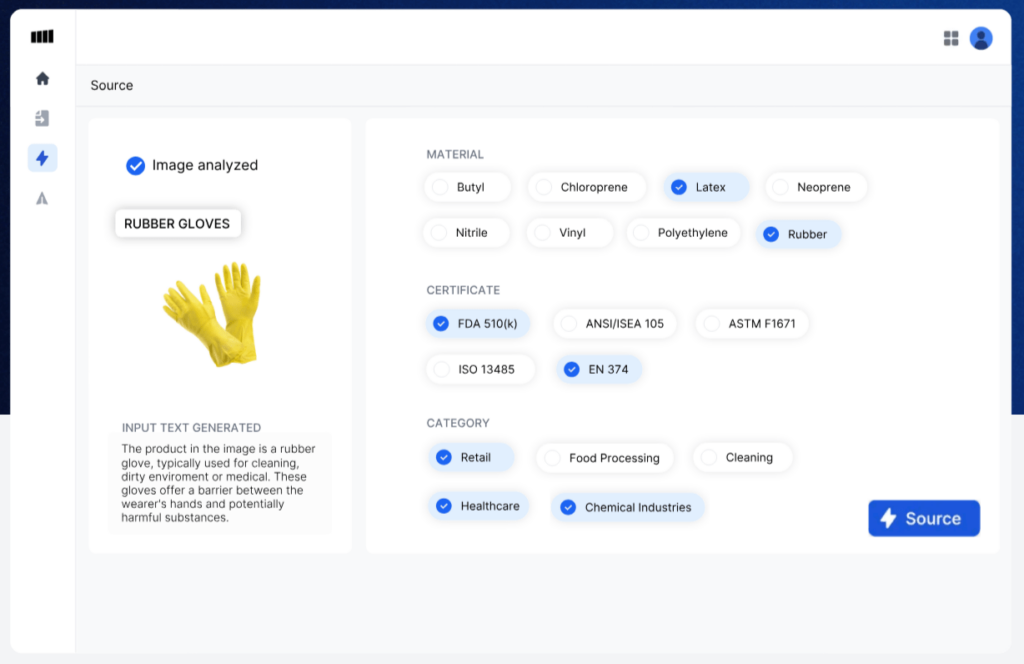
Source: Find my factory
Let’s take a look at the three core features offered by this software.
| Feature | Description |
|---|---|
| Enrich | The Enrich module uses AI to analyze supplier and product data, helping you find similar products or vendors. |
| Source | Five different search methods to find suppliers: smart search, URL, image search, supplier library, and product library. |
| Engage | Interact with suppliers, get automatic follow-ups, and integrate your communications with an email provider. |
One interesting feature is having different search options, including an AI-powered image search.
The idea behind this feature is to simply upload a picture of the product you need to source, and the platform will help you find suppliers offering similar products based on AI analysis.
However, keep in mind that Find My Factory’s database is relatively fresh, with only 8 million suppliers currently available.
Also, as of the time we’re writing this article, their new platform is still in limited release, with a waitlist you can sign up to.
Prices are on request and their main three plans are shown below, so contact them for specific details.

Source: Find my factory
As with most SaaS products, they offer a 14-day free trial if you sign up, which is a great option for seeing how Find My Factory works firsthand.
All in all, if you are interested in potentially powerful AI-driven search features and are willing to try a new solution on the market, Find My Factory could be a good option.
TealBook is a popular Supplier Data Platform (SDP) that automates the collection, verification, and enrichment of supplier data across your systems.
What sets TealBook apart is its unique technology. It creates a cloud-based layer of supplier data separate from your current procurement systems. This means all your procurement tools can use this clean, organized supplier data.

Source: TealBook
In simpler terms, TealBook helps you get a clearer picture of your current suppliers and make better choices about who to work with.
It also saves you from having to rely on supplier websites, internal teams, or search engines to find suppliers, which can be slow and frustrating.
The supplier data TealBook helps you gather includes:
This technology aims to speed up your research process and helps procurement teams view and manage all suppliers in one place.
In terms of data, TealBook has over 5 million supplier profiles and is still growing. While this is smaller than some other platforms, it’s trusted by big-name companies like Nasdaq, Goldman Sachs, The Home Depot, Peloton, and Freddie Mac.
If having all your supplier information in one organized, easy-to-use place is important to you, TealBook is definitely worth checking out.
Inven is an AI-powered web search tool that helps you cut down on manual searches.
While Inven is mainly aimed at helping M&A professionals find potential companies to acquire, procurement professionals can also use its strong search features to find suppliers.
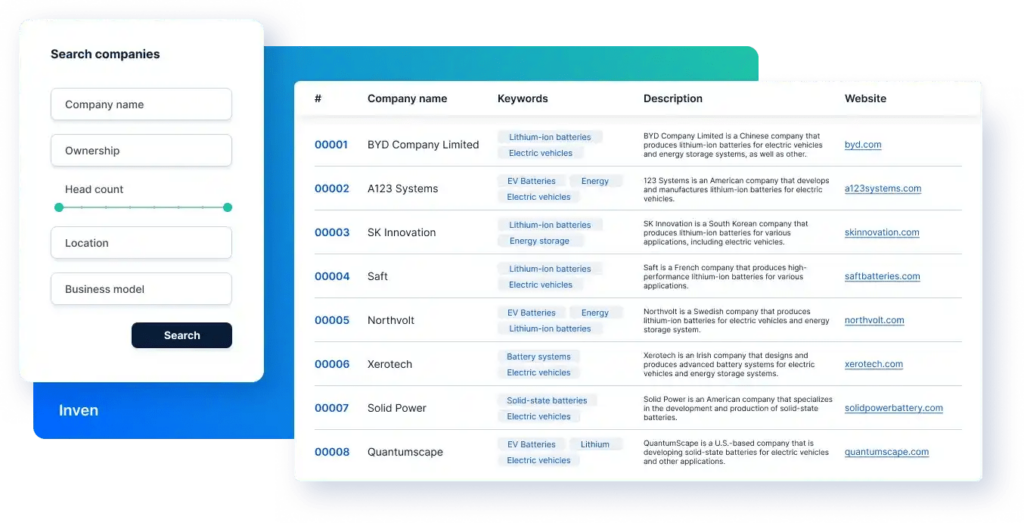
Source: Inven
Just by entering one or two examples of the company type you’re looking for, Inven’s AI will scan the internet to find similar businesses.
It then gives you a list with key information about each company, including verified contact details for titles like CEO, Founder, Owner, and Head of M&A.
Here’s a quick summary of Inven’s pros and cons, according to user reviews:
| Pros | Cons |
|---|---|
| Great customer support | Some problems with how it works |
| Easy to use | AI needs some fine-tuning |
| Search feature is mostly helpful | Revenue data isn’t always accurate |
| Great at finding the right companies | Database and suggestions need work |
| “Intent to sell” feature is useful for their target audience |
In summary, even though Inven is essentially designed for a specific purpose, it can still be a helpful tool for supplier discovery.
So, if you’re looking for a way to quickly find potential suppliers using AI web searches, Inven is a great option.
Our sixth tool on our list is DeepStream, a powerful cloud-based e-sourcing system that aims to optimize the entire source-to-contract process, including inviting, assessing, and negotiating with suppliers.
DeepStream uses an AI system for supplier discovery where you list out your requirements and their engine returns suggested suppliers in minutes.
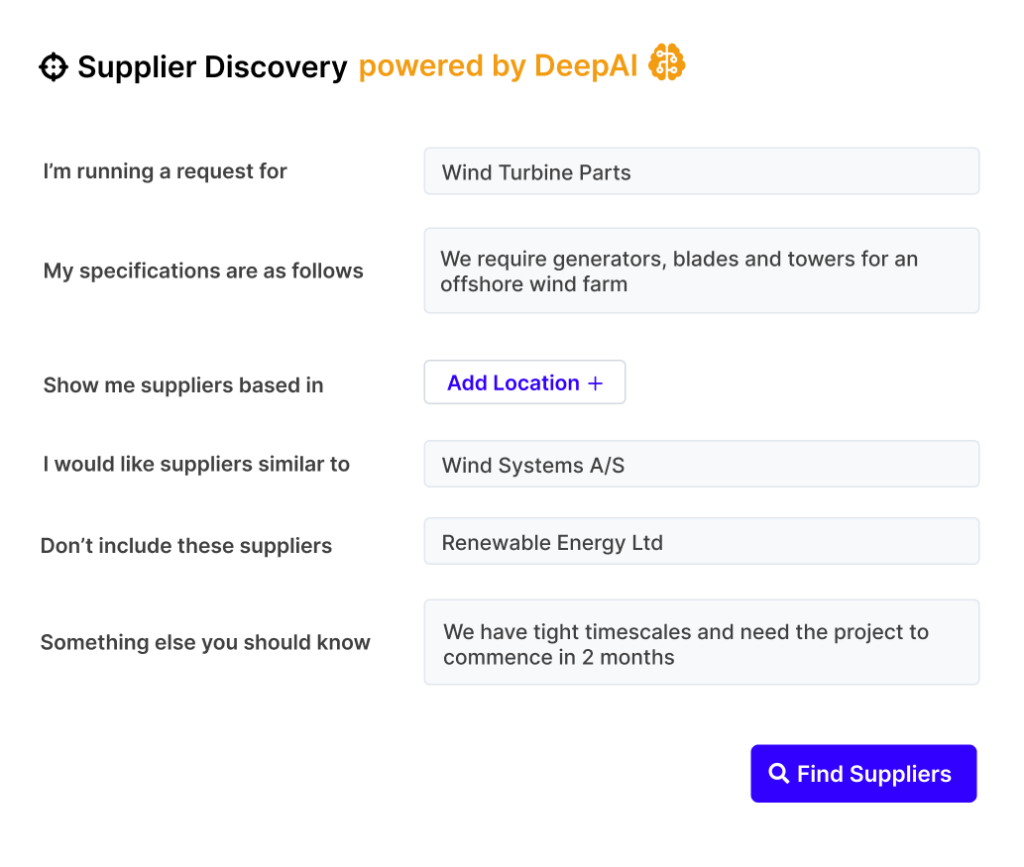
Source: DeepStream
This platform has generally positive reviews, scoring 4.7 out of 5 on G2, with users mostly praising the RFx and tendering process streamlining.
Some of the benefits frequently cited include user-friendliness and concise features, although users note there’s a slight learning curve.
Key Features:
Another interesting thing is their Supplier Analysis feature offering automated supplier evaluation. You can ask qualifying questions and define their format, making responses simple to assess.
In terms of pricing, you’ll need to contact their team for a custom quote tailored to your specific needs.
However, it’s worth noting that DeepStream doesn’t lock users in long contracts and offers the following packages.

Source: DeepStream
Overall, if a web-search-based platform with supplier prequalification options is what you’re looking for, DeepStream could be a good fit for you.
Scoutbee leverages AI and machine learning (ML) to allow procurement professionals to enhance their current supplier data, make more informed sourcing decisions, and discover and onboard new suppliers globally.
For new supplier discovery, Scoutbee’s AI engine uses web crawlers and other sources to gather data. ML algorithms then classify and enrich this data, providing context and valuable supplier insights.
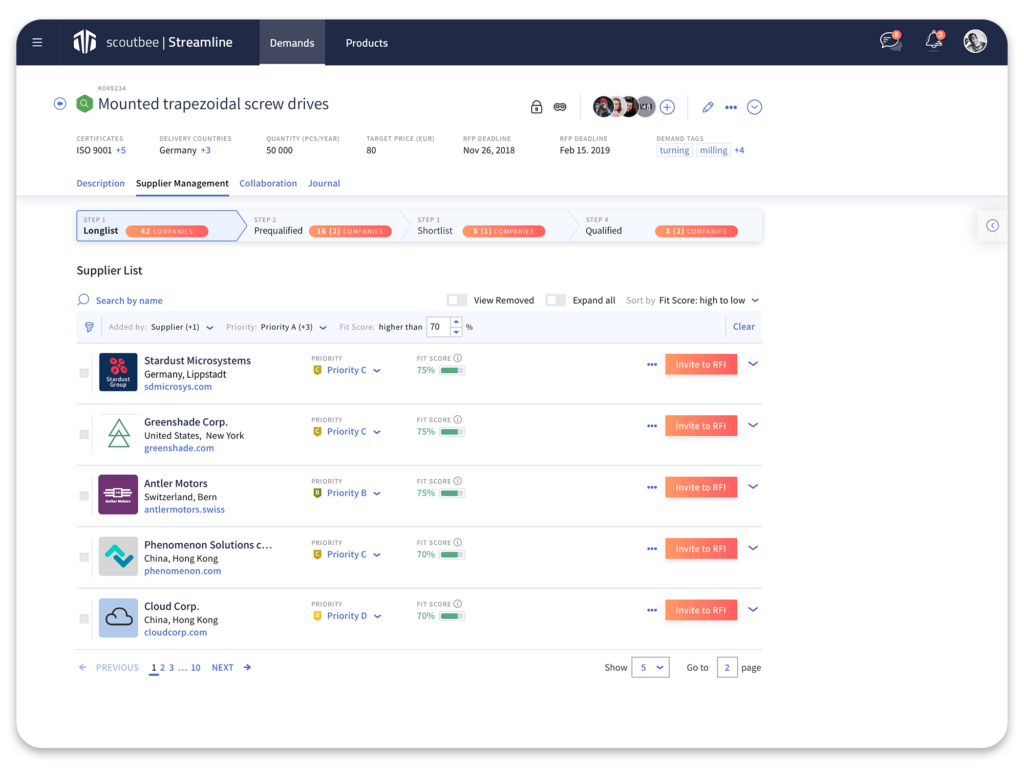
Source: Scoutbee
Scoutbee allows for a “Bring Your Own Data” approach for third-party data sources outside their network, allowing you to incorporate ESG data, supplier diversity, and other key factors in your supplier evaluation process.
This is one of the big benefits of the platform as it allows Scoutbee to act as a central hub for all your supplier data, offering powerful visualization and analytical tools to help you make sense of it all.
Scoutbee’s data aggregation, analysis, and AI search features made it a trusted tool by industry leaders in automotive, agriculture, energy, FMCG, industrial machinery, and the Life Science sector like Siemens, Audi, and Linde, among others.
Overall, Scoutbee might be an ideal solution for mid-sized to large enterprises seeking to centralize their supplier data and make data-driven decisions that optimize their sourcing strategies.
Last on our list is ProcurEngine, a cloud-based platform powered by AgileApt Solutions, which just recently celebrated 10 years of successful operation.
While primarily known for its e-auction and e-negotiation capabilities, ProcurEngine offers a full suite of procurement tools, including RFx, supplier lifecycle management, contract management, and spend analytics.
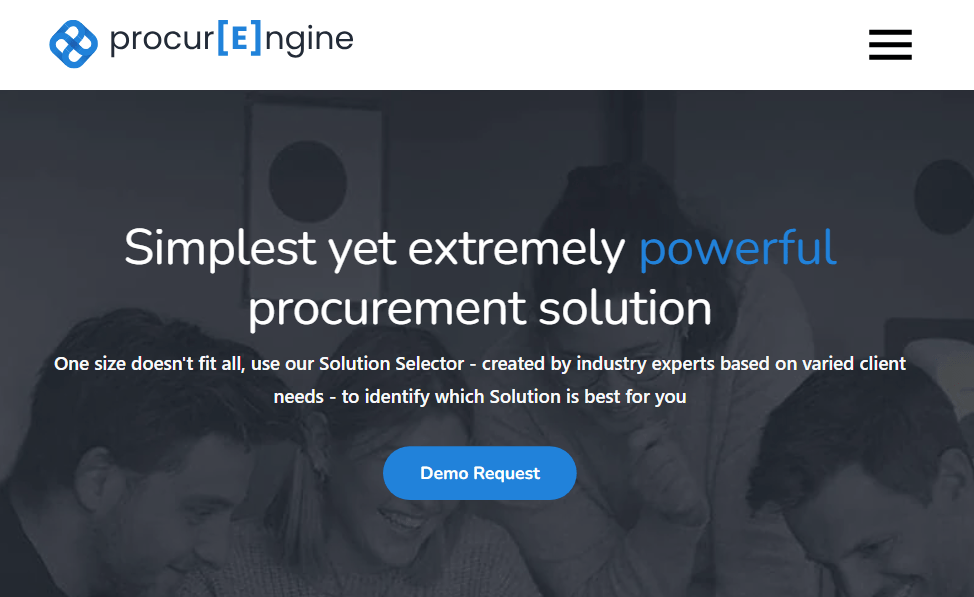
Source: ProcurEngine
Importantly, procurement teams can access ProcurEngine from any device, whether it’s a computer or a mobile phone, and at any time. This significantly enhances the tool’s flexibility and convenience, allowing you to manage your procurement activities on the go.
When it comes to supplier discovery, we can explore some of ProcurEngine’s listed features.

Source: ProcurEngine
They provide pre-qualification services by industry experts or third parties, ensuring that potential suppliers meet your specific requirements before you engage with them.
Additionally, they offer a more personalized approach to expanding your qualified supplier base. In fact, after you specify your supplier needs, their team identifies and suggests pre-evaluated suppliers who fit your criteria.
While specific details on these features are limited, ProcurEngine seems ideal for teams who prefer a more customized and collaborative approach, where supplier discovery is based on your unique needs and preferences.
And there you have it—eight supplier discovery software solutions that can help you find great suppliers in a short time.
Hopefully, we have introduced you to some tools you might want to explore further and apply to your operations.
It’s important to consider how any system aligns with your organization’s specific needs.
So, take a good look at your current supplier discovery process, think about where you’re struggling the most, and pick the tool that suits you best.